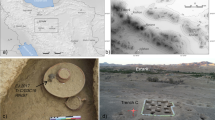Abstract
Pottery shards for daily use excavated from the Jinsha Site, a well-known archeological site in China, dated to the period from the late Shang Dynasty to the Western Zhou Dynasty (B.C. 1200–B.C. 771) in ancient China, were analyzed by making use of wavelength-dispersive X-ray fluorescence (WDXRF), X-ray diffraction (XRD) and Raman spectroscopy (RS). The results show that these pottery shards are mainly composed of SiO2, Al2O3, Fe2O3, K2O, P2O5, Na2O, TiO2 and CaO, as well as characterized by quartz (α-SiO2), feldspar (K- and NaAlSi3O8), calcite (CaCO3) and amorphous carbon. These pottery shards from different periods are similar in elemental composition and content, which probably suggests that there is not much difference in the raw materials used to produce these potteries for daily use. The identification of calcite indicates that the firing temperature of these potteries for daily use was probably less than 800 ℃, which implies that this type of pottery was probably fired in an open fire. The use of open firing method shows that the production technology of firing pottery for daily use was not advanced during the Shang and Zhou Dynasty. The complete study of these pottery shards is benefited by the application of multi-technique analytical method, which contributes to better understand the composition, the characteristic of the raw materials and firing method of pottery and provides the preliminary information for studying on the connection and difference of the pottery production technology between the Jinsha and Sanxingdui Site.







Similar content being viewed by others
Data availability
The datasets generated during and/or analyzed during the current study are available from the corresponding author on reasonable request.
References
Z.H. Jiang, Y. Wang, Q. Zhang, A preliminary research the predynastic Qin culture in the Chengdu plain. Acta Archaeological Sinica. 1, 1–22 (2002). (in Chinese)
D.A. Chen, Excavation of the sacrificial pit at Sanxingdui, Cultural Relics Publishing House, Beijing; 1999, pp. 19–399. (in Chinese)
Y. Wang, Jinsha: the ancient capital of Shu Dynasty reappearing its glory, Sichuan People's Publishing House, Chengdu; 2005, pp. 26–86. (in Chinese)
Z.H. Jiang, Preliminary analysis of jinsha site. Cultural Relics. 2, 122–135 (2010). (in Chinese)
J.S. Shi, Discussing Sanxingdui - Jinsha culture. Archaeol. Cultural Relics. 5, 65–72 (2020). (in Chinese)
Z.Y. Zhu, Q. Zhang, F. Wang, Discovery, excavation and significance of Jinsha Site in Chengdu. Sichuan Cultural Relics. 2, 3–8 (2002). (in Chinese)
L. Ye, M.T. Liu, W. Huang, S. Yang, Z. An, PIXE/RBS studies on ancient pottery from Jinsha ruins Site of Chengdu. Nucl. Phys. Rev. 27, 493–499 (2010)
Q.Q. Wu, J.J. Zhu, M.T. Liu, Z. Zhou, Z. An, W. Huang, Y.H. He, D.Y. Zhao, PIXE-RBS analysis on potteries unearthed from Lijiaba Site. Nucl. Instr. Meth. B. 296, 1–6 (2013)
Q. Q. Wu, Applications of ion beam Analysis technique in some researches. Chengdu, Sichuan University, Master thesis; P. 35. (in Chinese) (2013)
M. Yin, T. Rehren, J.M. Zheng, The earliest high-fired glazed ceramics in China: the composition of the proto-porcelain from Zhejiang during the Shang and Zhou periods (c. 1700e221 BC). J. Archaeol. Sci. 38, 2352–2365 (2011)
I. Nakai, Y. Abe, Portable X-ray powder diffractometer for the analysis of art and archaeological materials. Appl. Phys. A. 106, 279–293 (2012)
M.L. Franquelo, A. Duran, J. Castaing, D. Arquillo, J.L. Perez-Rodriguez, XRF, μ-XRD and μ-spectroscopic techniques for revealing the composition and structure of paint layers on polychrome sculptures after multiple restorations. Talanta 89, 462–469 (2012)
A. Klouzkova, M. Kohoutkova, P. Zemenova, Z. Mazac, Characterisation of a prehistorical ceramic object. J. Therm. Anal. Calorim. 116, 641–645 (2014)
L. Lutterotti, F. Dell’Amore, D.E. Angelucci, F. Carrer, S. Gialanella, Combined X-ray diffraction and fluorescence analysis in the cultural heritage field. Microchem. J. 126, 423–430 (2016)
M.A. Legodi, D. De Waal, Raman spectroscopic study of ancient South African domestic clay pottery. Spectrochim. Acta Part A. 66, 135–142 (2007)
S. Maria, Z. Marco, B. Evgeny, B. Mauro, K. Arun, G. Marco, S. Andrea, O. Beate, D. Nicola, G. Stefano, M. Gino, M. Maurizio, L. Luca, Mineralogical investigations using XRD, XRF, and Raman spectrometry in a combined approach. J. Raman Spectrosc. 49, 1023–1030 (2018)
P. Colomban, F. Ambrosi, A.T. Ngo, T.A. Lu, X.L. Feng, S. Chen, C.L. Choi, Comparative analysis of wucai chinese porcelains using mobile and fixed Raman microspectrometers. Ceram. Int. 43, 14244–14256 (2017)
T.J. Roache, J.L. Walshe, J.F. Huntington, M.A. Quigley, K. Yang, B.W. Bil, K.L. Blake, T. Hyvärinen, Epidote-clinozoisite as a hyperspectral tool in exploration for Archean gold. Aust. J. Earth Sci. 58, 813–822 (2011)
H. Maarten, C. Thomas, L. Carsten, G. Sean, Quantitative mineralogy from infrared spectroscopic data. I. validation of mineral abundance and composition scripts at the Rocklea channel iron deposit in western Australia. Econ. Geol. 107(2), 209–28 (2012)
L. Pereira-Pardo, M. Gil, B. Prieto, B. Silva, Multi-analytical approach to the material characterization of 16th century wall paintings from Ribeira Sacra (Galicia, NWSpain): pictorial palette, technique and alterations. Col. Res. Appl. 41, 263–269 (2016)
S. Akyuz, T. Akyuz, S. Basaran, C. Bolcal, A. Gulec, Analysis of ancient potteries using FT-IR, micro-Raman and EDXRF spectrometry. Vib. Spectrosc. 48, 276–280 (2008)
O.I. Ece, Z. Nakagawa, Bending strength of porcelains. Ceram. Int. 28, 131–140 (2002)
Y.S. Liou, Multi-technique study of archaeological cord-marked wares decorated with red coatings from Taiwan. J. Raman Spectrosc. 46, 133–140 (2015)
A. Issi, Estimation of ancient firing technique by the characterization of semi-fused Hellenistic potsherds from Harabebezikan/Turkey. Ceram. Int. 38, 2375–2380 (2012)
A.E. Lavat, M.C. Grasselli, J.E. Tasca, Phase changes of ceramic whiteware slip-casting bodies studied by XRD and FTIR. Ceram. Int. 33, 1111–1117 (2007)
M. Jiang, D. Y. Zhao,Jinsha Neolithic Shang, Zhou, Han, Ming and Qing ruins in Chengdu. Yearbook of Chinese Archaeology (2008), (Cultural Relics Publishing House, Beijing; 2009), pp. 373-374.(in Chinese)
X.L. Zhang, S.H. Chou, J. Zhong, Y. Huang, Report on radiocarbon dating (40). Archaeology 7, 83–84 (2014). (in Chinese)
A. Gianoncelli, J. Castaing, L. Ortega, E. Dooryhee, J. Salomon, P. Walter, J.L. Hodeau, P. Bordet, A portable instrument for in situ determination of the chemical and phase compositions of cultural heritage objects. X-Ray Spectrom. 37, 418–423 (2008)
P. Colombana, M. Maggettib, A. D’Albis, Non-invasive Raman identification of crystalline and glassy phases in a 1781 Sèvres royal factory soft paste porcelain plate. J. Eur. Ceram. Soc. 38, 5228–5233 (2018)
N.Q. Liem, G. Sagon, V.X. Quang, H.V. Tan, P. Colomban, Raman study of the microstructure, composition and processing of ancient Vietnamese (proto) porcelains and celadons (13–16th centuries). J. Raman Spectrosc. 31, 933–942 (2000)
P. Colomban, F. Treppoz, Identification and differentiation of ancient and modern European porcelains by Raman macro and micro-spectroscopy. J. Raman Spectrosc. 32, 93–102 (2001)
D. Bikiaris, S.X. Daniila, S. Sotiropoulou, O. Katsimbiri, E. Poulidou, A.P. Moutsatsou, Y. Chryssoulakis, Ochre-differentiation through micro-Raman and micro-FTIR spectroscopies: application on wall paintings at Meteora and Mount Athos. Greece. Spectrochim. Acta Part A. 56, 3–18 (1999)
R.L. Frost, P.M. Fredericks, J.R. Bartlett, Fourier transform Raman spectroscopy of kandite clays. Spectrochim. Acta Part A. 49, 667–674 (1993)
W.X. Liu, Modeling description and spectroscopic evidence of surface acid base properties of natural illites. Water Res. 35, 4111–4125 (2001)
R.L. Frost, L. Rintoul, Lattice vibrations of montmorillonite: an FT Raman and X-ray diffraction study. Appl. Clay Sci. 11, 171–183 (1996)
J.M. Alia, H.G.M. Edwards, F.J. Garcia-Navaro, J. Parras-Armenteros, C.J. Sanchez-Jimenez, Application of FT-Raman spectroscopy to quality control in brick clays firing process. Talanta 50, 291–298 (1999)
P.H. Colomban, Structure of oxide gels and glasses by infrared and Raman scattering. J. Mater. Sci. 24, 3011–3020 (1989)
E. Ingerson, in: F. Bruce, Bohor (Eds.), High temperature phase development in illitic clays, Proceedings of the 12th National Conference, Monograph No. 19, Pergamon, New York; 1971. p. 233
R. Gout, E.H. Oelkers, J. Schott, A. Zwick, The surface chemistry and structure of acid-leached albite: new insights on the dissolution mechanism of the alkali feldspars. Geochim. Cosmochim. Acta. 61, 3013–3018 (1997)
M.J. Wilson, Clay Mineralogy: Spectroscopic and Chemical Determinative Methods (Chapman and Hall, London, 1994), pp. 33–34
I.A. Degen, G.A. Newman, Raman spectra of inorganic ions. Spectrochim. Acta Part A. 49, 859–887 (1993)
M.M. Jordan, A. Boix, T. Sanfeliu, C. De la Fuente, Firing transformations of cretaceous clays used in the manufacturing of ceramic tiles. Appl. Clay Sci. 14, 225–234 (1999)
J.V. Owen, Quantification of early Worcester porcelain recipes and the distinction between Dr Wall- and Flight-period wares. J. Archaeol. Sci. 24, 301–310 (1997)
E. Jadot, N. Schiavon, M. Manso, The ceramics of Malpaís of Zacapu, Michoacán, Mexico, during the Early and Middle Postclassic periods (900–1450 AD): micro-chemical characterization of surface paintings. J. Raman Spectrosc. 119, 10–16 (2016)
M. Tabbal, T. Christidis, S. Isber, M.A. El Khakani, P. Merel, M. Chaker, Graphitic nanoclustering in pulsed laser deposited diamond-like-carbon and carbon nitride thin films. Thin Solid Films 453–454, 234–238 (2004)
R.N. Tarrant, D.R. McKenzie, M.M.M. Bilek, Raman characterisation of PIII multilayer carbon films. Diamond Relat. Mater. 13, 1422–1426 (2004)
K.H. Lee, H. Sugimura, Y. Inoue, O. Takai, Dependence of hybridizations analyzed by XPS and visible Raman spectroscopy on nanohardness and wear resistance of amorphous carbon and carbon nitride films. Diamond Relat. Mater. 13, 507–512 (2004)
J.C. Orlianges, C. Champeaux, A. Catherinot, T. Merle, B. Angleraud, Pulsed laser deposition of tetrahedral amorphous carbon films from glassy carbon and graphite targets: a comparative study. Thin Solid Films 453–454, 285–290 (2004)
Acknowledgements
The fund offered by Sichuan Science and Technology Program (project no. 2020ZDZX0004), China, is appreciated. Professor Jun Tang for his help in the XRD analysis, and Professor Guangxi Wang, Senior engineer Jiang Cheng and Mr. Xuejiang Wang for the help in the XRF analysis and the Professor Li Lei, Dr. Caishou Lin, Mr. Liping Luo and PhD student WenXue Li for their help in the Raman spectroscopy analysis are acknowledged. The Chengdu Center of China Geological Survey, the Analytical and Testing Center of Sichuan University are appreciated for the help in the analyses of XRF, respectively.
Author information
Authors and Affiliations
Corresponding author
Rights and permissions
About this article
Cite this article
Xu, Y., An, Z., Huang, N. et al. Analyzing the Shang-Western Zhou Dynasty pottery from the Jinsha Site with multi-technique method. Eur. Phys. J. Plus 136, 962 (2021). https://doi.org/10.1140/epjp/s13360-021-01952-5
Received:
Accepted:
Published:
DOI: https://doi.org/10.1140/epjp/s13360-021-01952-5




